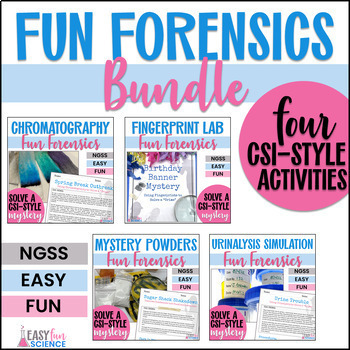Forensic Science Crime Scene Investigation Curriculum Middle School Lesson Plans
- Zip
- Easel Activity
What educators are saying
Products in this Bundle (4)
Bonus
Also included in
- Students LOVE the intrigue of CRIME SCENE INVESTIGATION! This 8-pack of Forensic Science Lesson Plans is the perfect addition to your curriculum, created for upper elementary and middle school students. They will love these not-scary mock crime scene activities! These CSI activities are easy to setPrice $22.00Original Price $32.00Save $10.00
Description
Looking for fun end of year activities, middle school teacher? Students LOVE the intrigue of Forensic Science CRIME SCENE INVESTIGATION! This 4-pack of Forensic Science Lesson Plans is the perfect addition to your curriculum, created for upper elementary and middle school students. They will love these not-scary mock crime scene activities! These CSI activities are easy to set up with common materials you can easily find at your local grocery store. Tested and approved by my students - these are FUN forensic science activities that your students will love! You will definitely want to add these hands-on experiments to your curriculum.
These Forensic Science resources are perfect for:
⭐ Traditional classrooms
⭐ Gifted Classroom
⭐ Homeschool Co-ops
⭐ Homeschool curriculum
Fingerprint Activity - Crime Scene Investigation (CSI)
In this CSI-type lab investigation for middle school students, students will identify FINGERPRINTS to solve a "crime." Unlike other forensics activities, this lab will not give your students nightmares!
Here is the scenario:
The science class surprised their teacher by decorating the classroom for her birthday. She wanted to thank the people who set up the surprise, but no one would take credit. She turned the situation into a “teachable moment.” The microscope slides that were on her desk earlier that day were moved to another table. Whoever hung the birthday banner must have moved some of the slides out of the way to make room for the banner. They would use the fingerprints left behind on the microscope slides to solve the Birthday Banner Mystery.
Spring Break Outbreak - Chemistry in Forensics Paper Chromatography Lab introduces students to forensics and how investigators use chemistry in forensics to solve crimes.
Here is the scenario:
There has been an influenza outbreak in the science class. Students analyze the evidence using paper chromatography to link the suspect to the crime.
Sugar Shack Shakedown - Mystery Powders Lab
Students will observe and test five known substances to determine if a new substance is made. Then, they will use this information to determine the identity of the evidence that was found in the suspect’s car.
Through this investigation, students will identify materials based on their properties, determine if new substances are made, and therefore determine if a chemical reaction has occurred.
Here is the scenario:
Someone has broken into the Sugar Shack Bakery and stolen the secret ingredient in the Death by Chocolate Cake recipe! Using samples from the bakery and evidence found in the suspect’s car, you will help solve the crime.
Urine Trouble - Urinalysis Simulation
In this investigation, students will perform a mock urinalysis on four suspects. In doing so, they will learn about common health problems that can be detected through urinalysis. These health problems commonly arise from dietary choices. Students will make observations of the color and clarity of the urine, test each suspect’s urine for proteins and sugar, and determine the pH of each sample.
Here is the scenario:
Someone at Camp Wannabegood has not been flushing the toilet - gross! Could it be a camper, a counselor or the camp director?
BONUS: Simple Machines Interactive Folder
This interactive folder is unlike any other! Students will create working paper models of each simple machine.
Looking for more Fun Forensics activities? Check out...
- Halloween Forensic Science Crime Scene Investigation Blood Spatter Activity
- Thanksgiving Forensics CSI DNA Extraction and Fingerprinting Gel Electrophoresis
- Forensic Science Christmas Activity Crime Scene Investigation & Fat Analysis
- Valentine's Day Forensic Science Crime Scene Investigation (CSI) Activity
FUN FORENSICS BUNDLES:
- Holiday Crime Scene Investigation Bundle of 4 (Halloween, Thanksgiving, Christmas/Holiday, Valentine's Day)
- Forensic Science Mega Bundle of 8 (Urinalysis, Mystery Powders, Chromatography, Fingerprinting, Halloween, Thanksgiving, Christmas/Holiday, Valentine's Day)
Don't forget to FOLLOW ME - all new products are 50% off for the first 24 hours. You will get only notifications of new products by following me here.
Would you like FREE Science Resources? Head over to my website and sign up for my weekly newsletter, full of freebies, science tips and updates. EasyFunScience.com
Not finding what you are looking for? I am happy to take requests for the resources you are looking for. Simply go to the "Ask a Question" on my store page to contact me directly.
You can also find me on Instagram at Easy.Fun.Science






